Development of Probiotic Fermented Sausages and Viability Monitoring of Supplemented Lactiplantibacillus plantarum BFL Strain
Abstract
1. Introduction
2. Materials and Methods
2.1. Bacterial Cultures
2.2. Salamines Criollos Preparation
2.3. Characterization of L. plantarum BFL Microcapsules
2.4. Experimental Design
2.5. Determination of pH
2.6. Lactiplantibacillus plantarum BFL Strain Survival
2.7. Microbiological Analysis
2.8. Evaluation of Lipid Oxidation
2.9. Color Measurement
2.10. Texture Profile Analysis
2.11. Statistical Analysis
3. Results and Discussion
3.1. Characterization of L. plantarum BFL Microcapsules
3.2. Changes in pH
3.3. Monitoring L. plantarum BFL Strain Survival
3.4. Microbiological Analysis
3.5. Lipid Oxidation
3.6. Color Measurement
3.7. Texture Profile Analysis (TPA)
4. Conclusions
Author Contributions
Funding
Institutional Review Board Statement
Informed Consent Statement
Data Availability Statement
Acknowledgments
Conflicts of Interest
References
- Marco, M.L.; Sanders, M.E.; Gänzle, M.; Arrieta, M.C.; Cotter, P.D.; De Vuyst, L.; Hill, C.; Holzapfel, W.; Lebeer, S.; Merenstein, D.; et al. The International Scientific Association for Probiotics and Prebiotics (ISAPP) Consensus Statement on Fermented Foods. Nat. Rev. Gastroenterol. Hepatol. 2021, 18, 196–208. [Google Scholar] [CrossRef]
- Zhao, B.; Zhou, H.; Zhang, S.; Pan, X.; Li, S.; Zhu, N.; Wu, Q.; Wang, S.; Qiao, X.; Chen, W. Changes of Protein Oxidation, Lipid Oxidation and Lipolysis in Chinese Dry Sausage with Different Sodium Chloride Curing Salt Content. Food Sci. Hum. Wellness 2020, 9, 328–337. [Google Scholar] [CrossRef]
- Sirini, N.; Lucas-González, R.; Fernández-López, J.; Viuda-Martos, M.; Pérez-Álvarez, J.A.; Frizzo, L.S.; Signorini, M.L.; Zbrun, M.V.; Rosmini, M.R. Effect of Probiotic Lactiplantibacillus plantarum and Chestnut Flour (Castanea Sativa Mill) on Microbiological and Physicochemical Characteristics of Dry-Cured Sausages during Storage. Meat Sci. 2022, 184, 108691. [Google Scholar] [CrossRef]
- Sirini, N.; Roldán, A.; Lucas-González, R.; Fernández-López, J.; Viuda-Martos, M.; Pérez-Álvarez, J.A.; Frizzo, L.S.; Rosmini, M.R. Effect of Chestnut Flour and Probiotic Microorganism on the Functionality of Dry-Cured Meat Sausages. LWT 2020, 134, 110197. [Google Scholar] [CrossRef]
- Klingberg, T.D.; Axelsson, L.; Naterstad, K.; Elsser, D.; Budde, B.B. Identification of Potential Probiotic Starter Cultures for Scandinavian-Type Fermented Sausages. Int. J. Food Microbiol. 2005, 105, 419–431. [Google Scholar] [CrossRef]
- Stadnik, J.; Kęska, P. Meat and Fermented Meat Products as a Source of Bioactive Peptides. Acta Sci. Pol. Technol. Aliment. 2015, 14, 181–190. [Google Scholar] [CrossRef]
- Sirini, N.; Frizzo, L.S.; Aleu, G.; Soto, L.P.; Rosmini, M.R. Use of Probiotic Microorganisms in the Formulation of Healthy Meat Products. Curr. Opin. Food Sci. 2021, 38, 141–146. [Google Scholar] [CrossRef]
- Muthukumarasamy, P.; Holley, R.A. Microbiological and Sensory Quality of Dry Fermented Sausages Containing Alginate-Microencapsulated Lactobacillus Reuteri. Int. J. Food Microbiol. 2006, 111, 164–169. [Google Scholar] [CrossRef] [PubMed]
- de Oliveira Gomes, B.; de Mesquita Oliveira, C.; de Marins, A.R.; Gomes, R.G.; Feihrmann, A.C. Application of microencapsulated probiotic Bifidobacterium animalis ssp. lactis BB-12 in Italian salami. J. Food Processing Preserv. 2021, 45, e15841. [Google Scholar]
- Bujalance, C.; Jiménez-Valera, M.; Moreno, E.; Ruiz-Bravo, A. A Selective Differential Medium for Lactobacillus plantarum. J. Microbiol. Methods 2006, 66, 572–575. [Google Scholar] [CrossRef]
- Rosmini, M.R.; Perlo, F.; Pérez-Alvarez, J.A.; Pagán-Moreno, M.J.; Gago-Gago, A.; López-Santoveña, F.; Aranda-Catalá, V. TBA Test by an Extractive Method Applied to ‘Paté’. Meat Sci. 1996, 42, 103–110. [Google Scholar] [CrossRef]
- Herrero, A.M.; Ordóñez, J.A.; de Avila, R.; Herranz, B.; de la Hoz, L.; Cambero, M.I. Breaking Strength of Dry Fermented Sausages and Their Correlation with Texture Profile Analysis (TPA) and Physico-Chemical Characteristics. Meat Sci. 2007, 77, 331–338. [Google Scholar] [CrossRef] [PubMed]
- Tao, T.; Ding, Z.; Hou, D.; Prakash, S.; Zhao, Y.; Fan, Z.; Zhang, D.; Wang, Z.; Liu, M.; Han, J. Influence of Polysaccharide as Co-Encapsulant on Powder Characteristics, Survival and Viability of Microencapsulated Lactobacillus paracasei Lpc-37 by Spray Drying. J. Food Eng. 2019, 252, 10–17. [Google Scholar] [CrossRef]
- Nunes, G.L.; de Araújo Etchepare, M.; Cichoski, A.J.; Zepka, L.Q.; Jacob Lopes, E.; Barin, J.S.; de Moraes Flores, É.M.; de Bona da Silva, C.; de Menezes, C.R. Inulin, Hi-Maize, and Trehalose as Thermal Protectants for Increasing Viability of Lactobacillus acidophilus Encapsulated by Spray Drying. LWT 2018, 89, 128–133. [Google Scholar] [CrossRef]
- Barajas-Álvarez, P.; González-Ávila, M.; Espinosa-Andrews, H. Microencapsulation of Lactobacillus Rhamnosus HN001 by Spray Drying and Its Evaluation under Gastrointestinal and Storage Conditions. LWT 2022, 153, 112485. [Google Scholar] [CrossRef]
- Trząskowska, M.; Kołożyn-Krajewska, D.; Wójciak, K.; Dolatowski, Z. Microbiological Quality of Raw-Fermented Sausages with Lactobacillus Casei LOCK 0900 Probiotic Strain. Food Control 2014, 35, 184–191. [Google Scholar] [CrossRef]
- Gardiner, G.E.; O’sullivan, E.; Kelly, J.; Auty, M.A.E.; Fitzgerald, G.F.; Collins, J.K.; Stanton, C. Comparative survival rates of human-derived probiotic Lactobacillus paracasei and L. salivarius strains during heat treatment and spray drying. Appl. Environ. Microbiol. 2000, 66, 2605–2612. [Google Scholar] [CrossRef] [PubMed]
- Shori, A.B. Microencapsulation Improved Probiotics Survival During Gastric Transit. HAYATI J. Biosci. 2017, 24, 1–5. [Google Scholar] [CrossRef]
- Ben Slima, S.; Ktari, N.; Trabelsi, I.; Triki, M.; Feki-Tounsi, M.; Moussa, H.; Makni, I.; Herrero, A.; Jiménez-Colmenero, F.; Ruiz-Capillas Perez, C.; et al. Effect of Partial Replacement of Nitrite with a Novel Probiotic Lactobacillus plantarum TN8 on Color, Physico-Chemical, Texture and Microbiological Properties of Beef Sausages. LWT 2017, 86, 219–226. [Google Scholar] [CrossRef]
- Blaiotta, G.; Murru, N.; Di Cerbo, A.; Romano, R.; Aponte, M. Production of Probiotic Bovine Salami Using Lactobacillus plantarum 299v as Adjunct. J. Food Sci. 2018, 98, 2285–2294. [Google Scholar] [CrossRef]
- Pavli, F.G.; Argyri, A.A.; Chorianopoulos, N.G.; Nychas, G.-J.E.; Tassou, C.C. Effect of Lactobacillus plantarum L125 Strain with Probiotic Potential on Physicochemical, Microbiological and Sensorial Characteristics of Dry-Fermented Sausages. LWT 2020, 118, 108810. [Google Scholar] [CrossRef]
- Soto, L.P.; Sirini, N.E.; Frizzo, L.S.; Zbrun, M.V.; Zimmermann, J.A.; Ruiz, M.J.; Rosmini, M.R.; Sequeira, G.J.; Miotti, C.; Signorini, M.L. Lactic Acid Bacteria Viability in Different Refrigerated Food Matrices: A Systematic Review and Meta-analysis. Crit. Rev. Food Sci. Nutr. 2022. [Google Scholar] [CrossRef] [PubMed]
- Nissen, H.; Holck, A. Survival of Escherichia Coli O157:H7, Listeria monocytogenes and Salmonella kentucky in Norwegian Fermented, Dry Sausage. Food Microbiol. 1998, 15, 273–279. [Google Scholar] [CrossRef]
- Pinto, R.A.; de Paula, A.V.; Rossi, E.A.; de Valdez, G.F.; Roselino, M.N.; Cavallini, D.C.U.; Ract, J.N.R.; de Almeida, J.F.; Canaan, J.M.M. Safety of a Low-Fat Fermented Sausage Produced with Enterococcus Faecium CRL 183 and Lactobacillus acidophilus CRL1014 Probiotic Strains. Int. Food Res. J. 2017, 24, 2694–2704. [Google Scholar]
- Yu, D.; Feng, M.; Sun, J. Influence of Mixed Starters on the Degradation of Proteins and the Formation of Peptides with Antioxidant Activities in Dry Fermented Sausages. Food Control 2021, 123, 107743. [Google Scholar] [CrossRef]
- Aksu, M.İ.; Kaya, M.; Ockerman, H.W. Effect of Modified Atmosphere Packaging, Storage Period, and Storage Temperature on the Residual Nitrate of Sliced-Pastırma, Dry Meat Product, Produced from Fresh Meat and Frozen/Thawed Meat. Food Chem. 2005, 93, 237–242. [Google Scholar] [CrossRef]
- Dong, C.; Wang, B.; Li, F.; Zhong, Q.; Xia, X.; Kong, B. Effects of Edible Chitosan Coating on Harbin Red Sausage Storage Stability at Room Temperature. Meat Sci. 2020, 159, 107919. [Google Scholar] [CrossRef] [PubMed]
- Pérez-Alvarez, J.A.; Sayas-Barberá, M.E.; Fernández-López, J.; Aranda-Catalá, V. Physicochemical Characteristics of Spanish-Type Dry-Cured Sausage. Food Res. Int. 1999, 32, 599–607. [Google Scholar] [CrossRef]
- López, J.F. Estudio del Color Por Metodos Objetivos en Sistemas Modelo de Pastas de Embutidos Crudo-Curados. Universidad de Murcia. 1998. Available online: http://purl.org/dc/dcmitype/Text (accessed on 5 September 2022).
- Cavalheiro, C.P.; Ruiz-Capillas, C.; Herrero, A.M.; Jiménez-Colmenero, F.; Pintado, T.; de Menezes, C.R.; Fries, L.L.M. Effect of Encapsulated Lactobacillus plantarum as Probiotic on Dry-Sausages during Chilled Storage. IJFST 2020, 55, 3613–3621. [Google Scholar] [CrossRef]
- Hu, Y.; Zhang, L.; Zhang, H.; Wang, Y.; Chen, Q.; Kong, B. Physicochemical Properties and Flavour Profile of Fermented Dry Sausages with a Reduction of Sodium Chloride. LWT 2020, 124, 109061. [Google Scholar] [CrossRef]
- Burgain, J.; Gaiani, C.; Cailliez-Grimal, C.; Jeandel, C.; Scher, J. Encapsulation of Lactobacillus Rhamnosus GG in Microparticles: Influence of Casein to Whey Protein Ratio on Bacterial Survival during Digestion. Food Sci. Technol. 2013, 19, 233–242. [Google Scholar] [CrossRef]
- Hansen, L.T.; Allan-Wojtas, P.M.; Jin, Y.-L.; Paulson, A.T. Survival of Ca-Alginate Microencapsulated Bifidobacterium spp. in Milk and Simulated Gastrointestinal Conditions. Food Microbiol. 2002, 19, 35–45. [Google Scholar] [CrossRef]
- Zhu, Y.; Guo, L.; Yang, Q. Partial Replacement of Nitrite with a Novel Probiotic Lactobacillus plantarum on Nitrate, Color, Biogenic Amines and Gel Properties of Chinese Fermented Sausages. Food Res. Int. 2020, 137, 109351. [Google Scholar] [CrossRef] [PubMed]
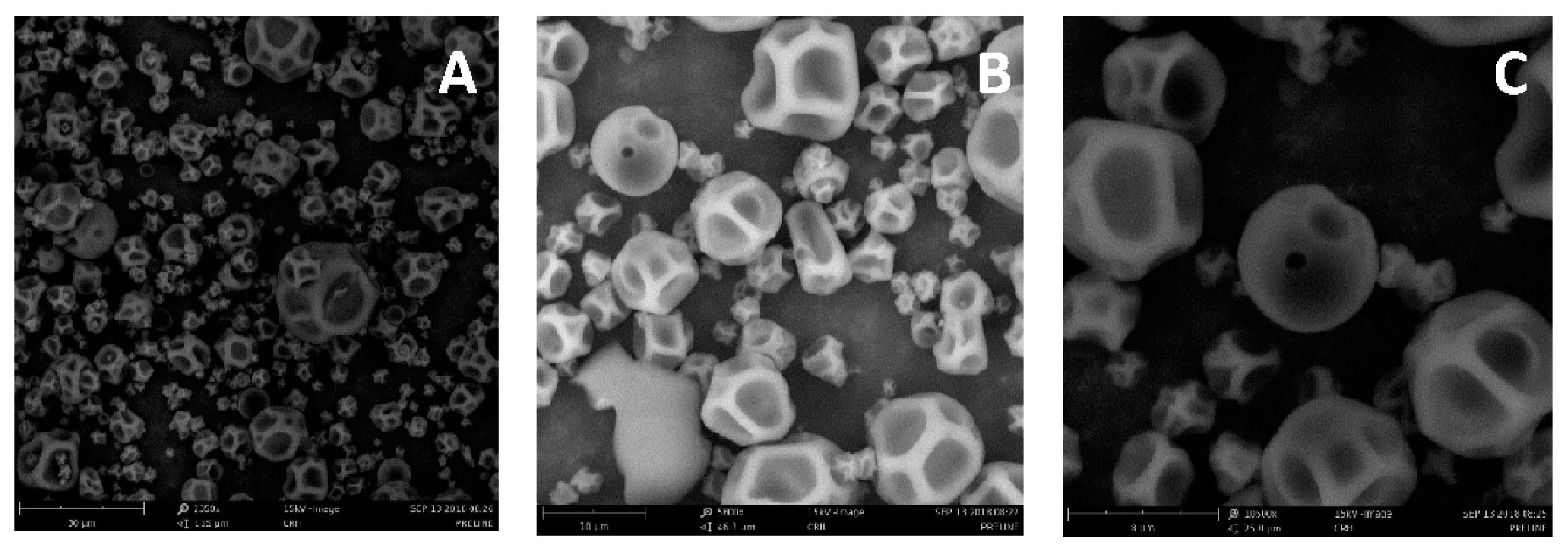

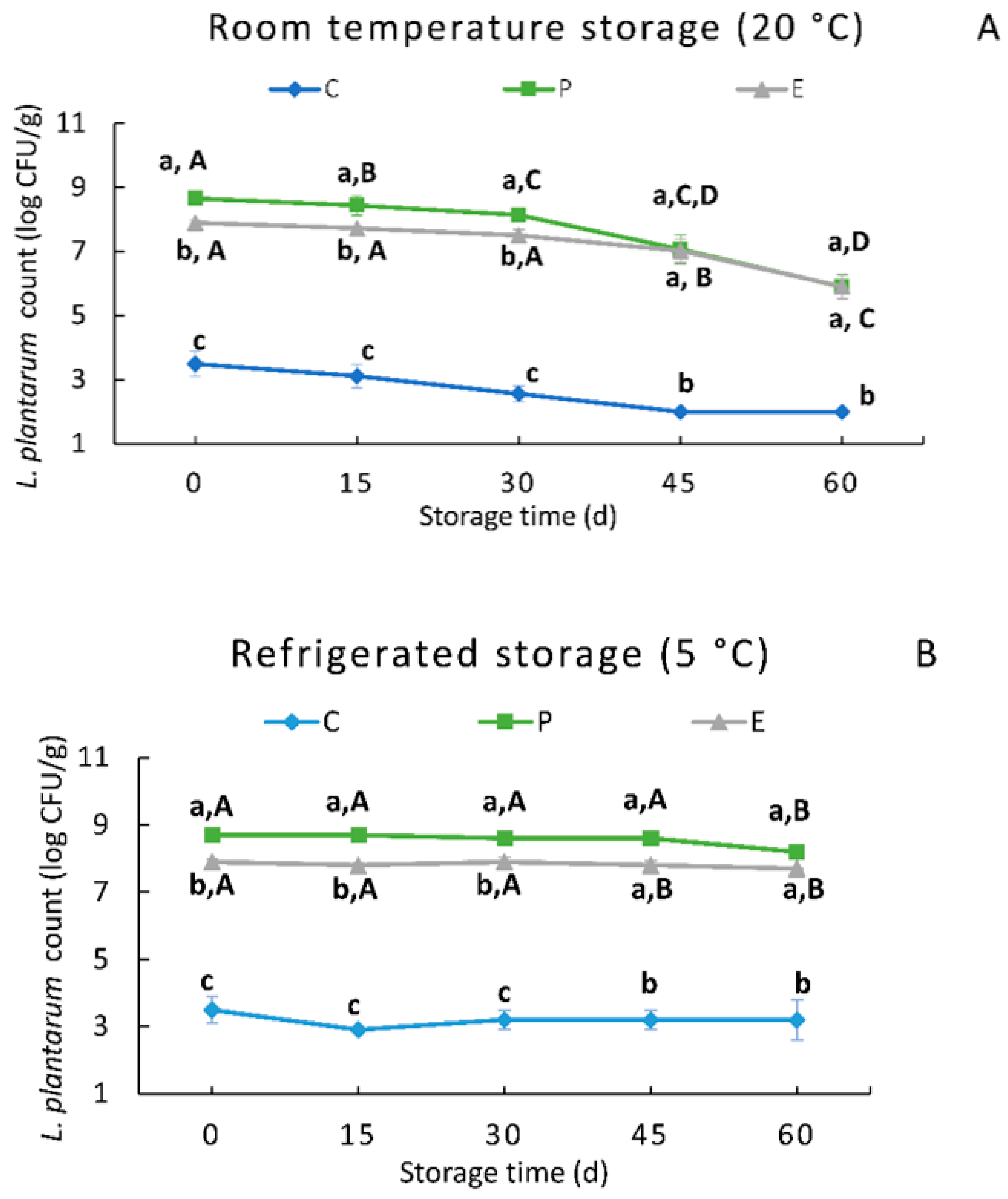

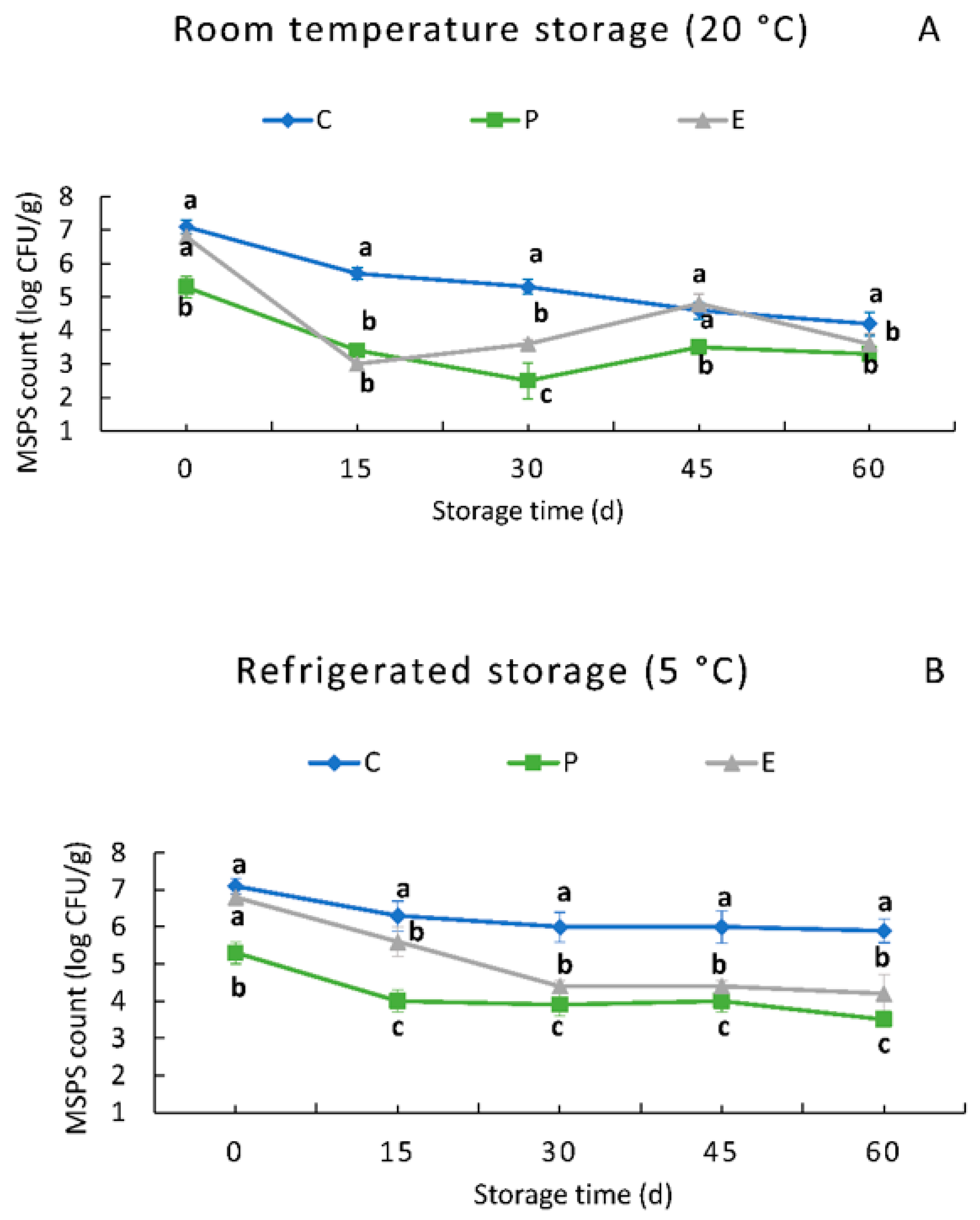
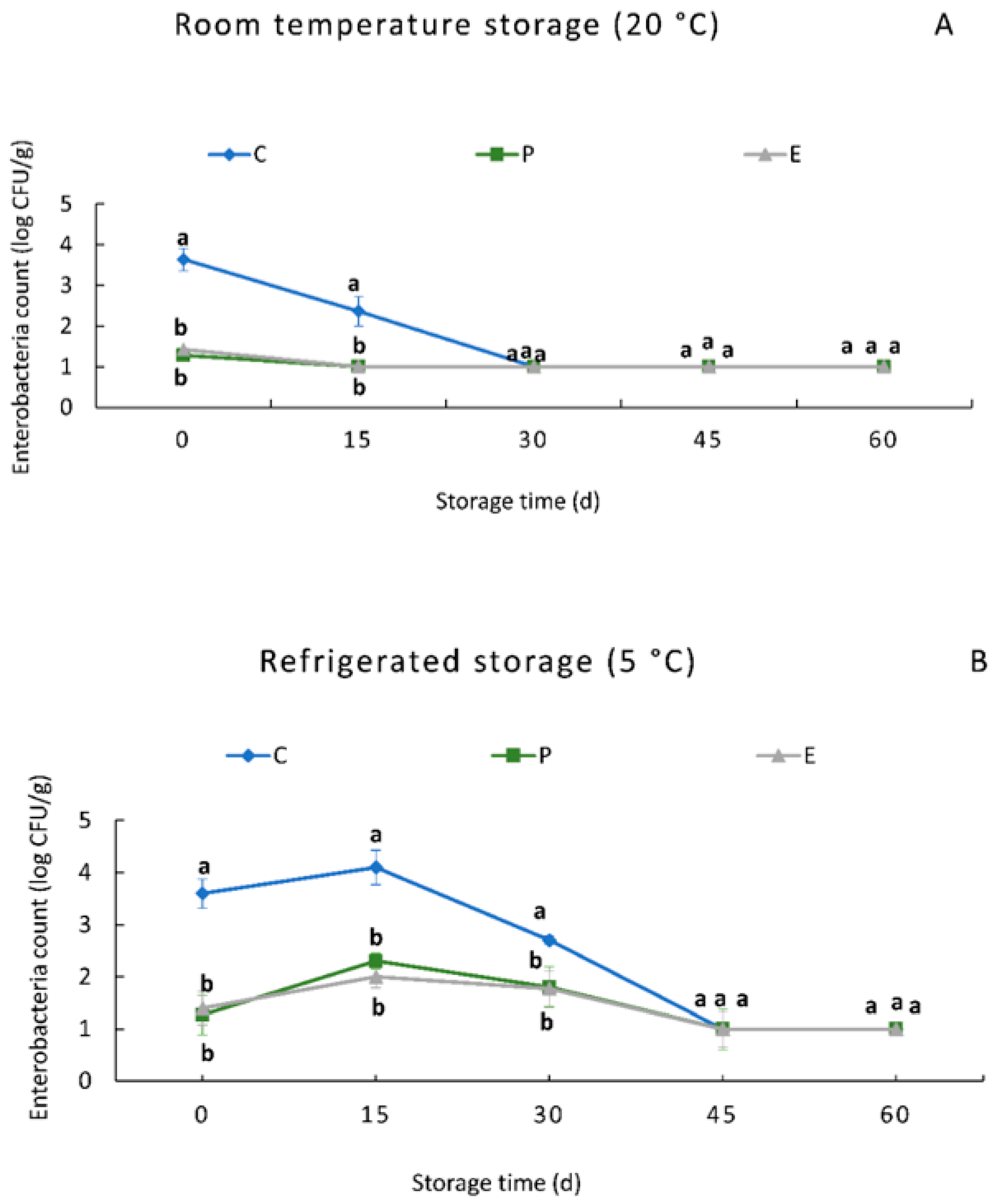
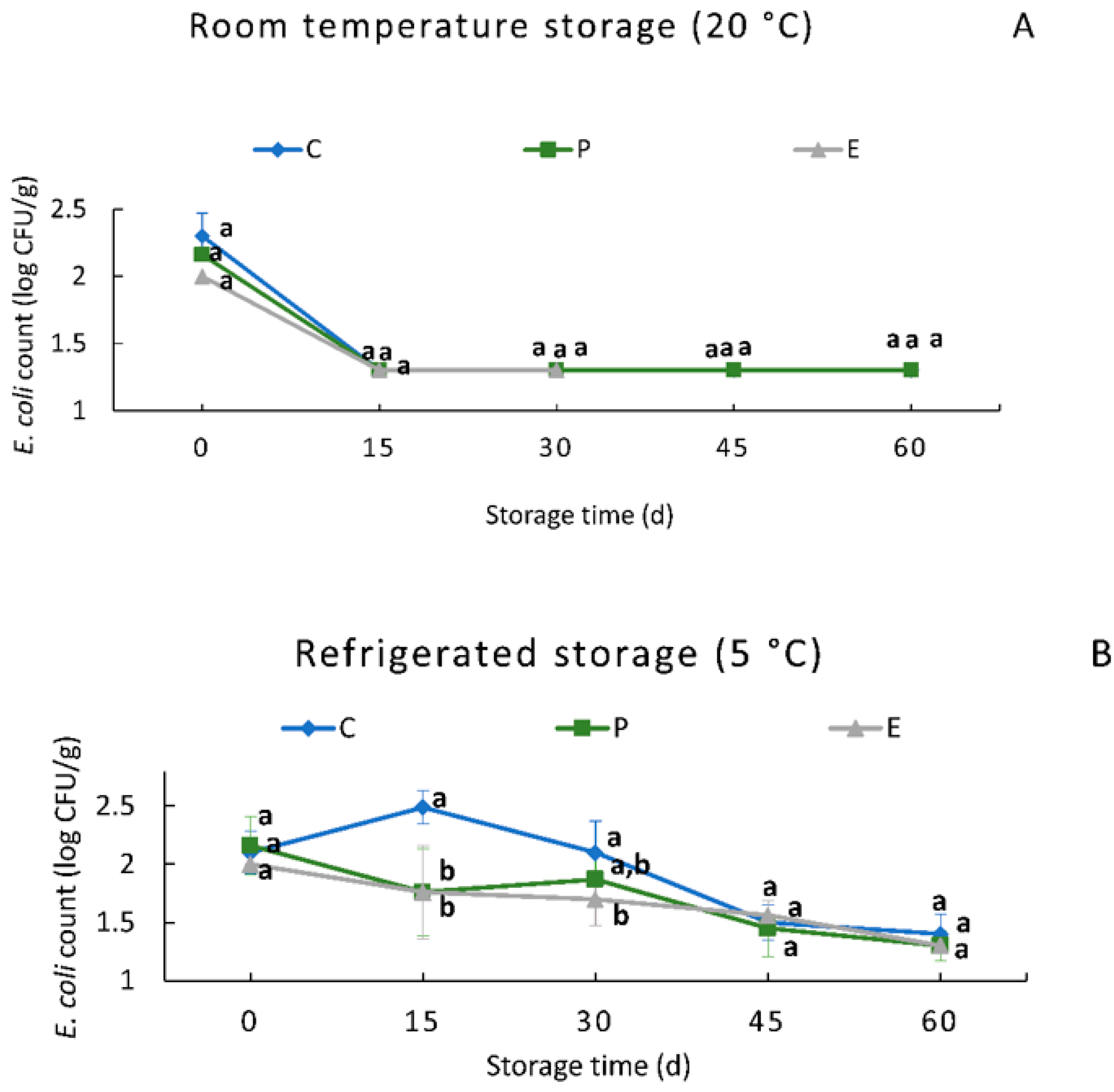
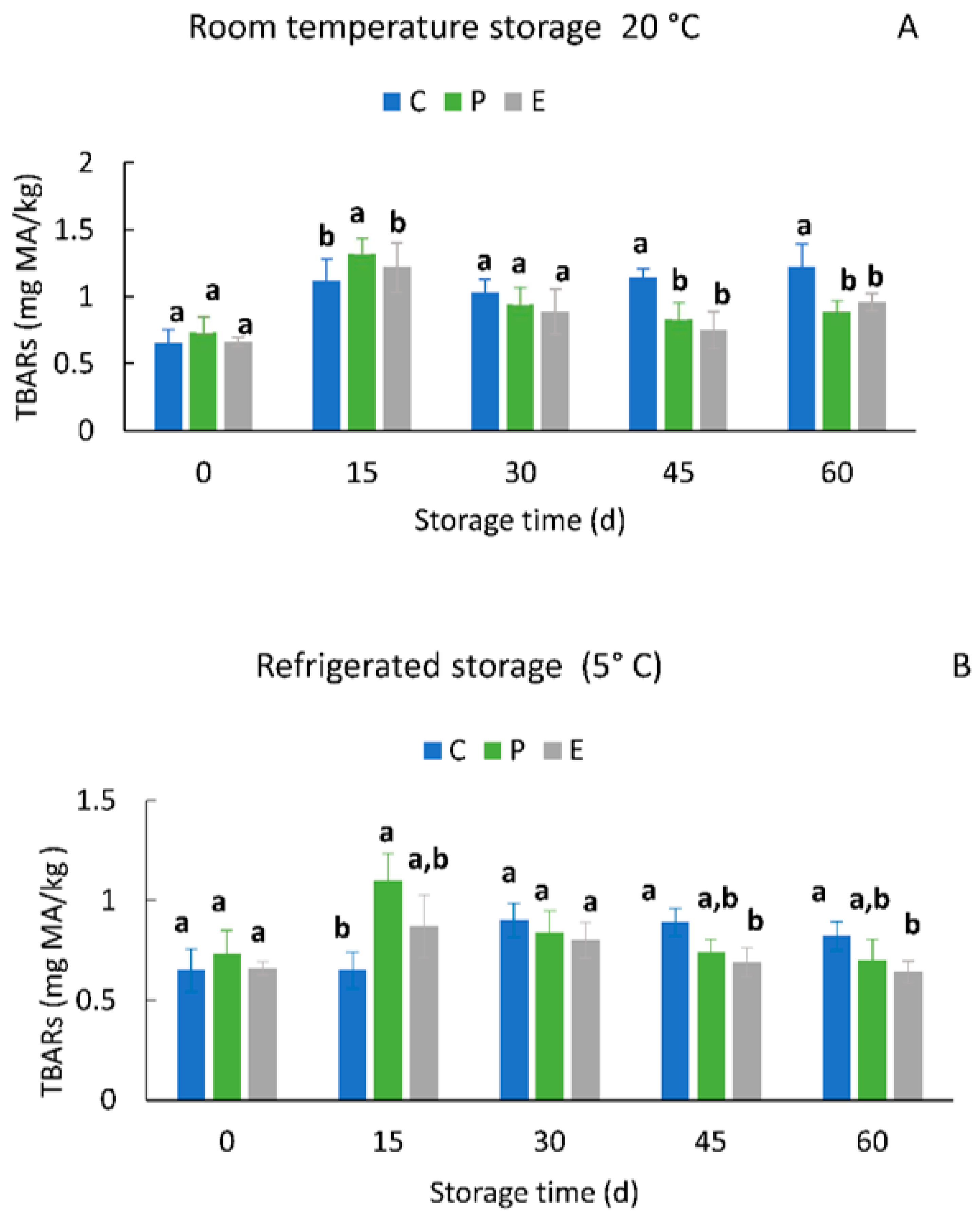
| Color Measurement | ||||||
|---|---|---|---|---|---|---|
| 20 °C | Treatment | L* | a* | b* | h* | C* |
| 0 d | C | 31.38 ± 1.3 c | 17.06 ± 0.8 a | 7.55 ± 0.5 a | 0.42 ± 0.01 a | 18.66 ± 0.89 a |
| P | 39.20 ± 0.8 a | 17.34 ± 0.6 a | 7.60 ± 0.4 a | 0.41 ± 0.01 a | 18.91 ± 0.71 a | |
| E | 37.67 ± 1.0 b | 17.83 ± 0.2 a | 10.91 ± 7.3 a | 0.51 ± 0.23 a | 21.50 ± 4.70 a | |
| 15 d | C | 31.52 ± 2.9 c | 14.13 ± 0.5 b | 7.16 ± 0.7 b,c | 0.47 ± 0.03 a | 15.84 ± 0.59 a |
| P | 38.06 ± 0.3 a | 16.35 ± 2.0 a | 8.01 ± 0.4 a | 0.46 ± 0.04 a | 18.22 ± 1.93 a | |
| E | 34.78 ± 0.5 b | 17.00 ± 1.2 a | 7.31 ± 0.4 b | 0.41 ± 0.01 a | 18.50 ± 1.26 a | |
| 30 d | C | 29.99 ± 0.7 b | 14.76 ± 0.5 c | 7.11 ± 0.2 b | 0.45 ± 0.02 a | 16.38 ± 0.46 b |
| P | 37.77 ± 0.6 a | 15.96 ± 0.2 b | 7.65 ± 0.2 a | 0.47 ± 0.01 a | 17.70 ± 0.12 a,b | |
| E | 36.40 ± 0.9 a | 16.55 ± 1.2 a | 7.64 ± 0.7 a | 0.43 ± 0.07 a | 18.23 ± 1.34 a | |
| 45 d | C | 30.5 ± 0.4 a | 15.683 ± 0.2 c | 7.65 ± 0.5 a | 0.45 ± 0.02 a | 17.45 ± 0.37 b |
| P | 38.2 ± 0.21 b | 16.46 ± 0.2 b | 7.66 ± 0.3 a | 0.43 ± 0.02 a | 18.16 ± 0.22 a | |
| E | 36.31 ± 1.6 b | 17.04 ± 0.3 a | 7.76 ± 0.1 a | 0.43 ± 0.02 a | 18.73 ± 0.33 b | |
| 60 d | C | 30.42 ± 0.9 b | 15.33 ± 0.4 b | 7.39 ±0.4 a | 0.45 ± 0.02 a | 17.03 ± 0.53 b |
| P | 37.15 ± 0.2 a | 16.92 ± 0.5 a | 7.80 ± 0.2 a | 0.43 ± 0.01 a | 18.63 ± 0.55 a | |
| E | 36.70 ± 0.8 a | 16.19± 0.7 a | 7.48 ± 1.5 a | 0.43 ± 0.02 a | 17.84 ± 0.91 a,b | |
| 5 °C | Treatment | L* | a* | b* | h* | C* |
| 0 d | C | 31.38 ± 1.3c | 17.06 ± 0.8 a | 7.55 ± 0.5 a | 0.42 ± 0.01 a | 18.66 ± 0.9 a |
| P | 39.20 ± 0.8 a | 17.32 ± 0.6 a | 7.60 ± 0.4 a | 0.41 ± 0.02 a | 18.92 ± 0.71 a | |
| E | 37.67 ± 1.0 b | 17.83 ± 0.2 a | 10.91 ± 7.3 a | 0.51 ± 0.23 a | 21.50 ± 4.7 a | |
| 15 d | C | 32.95 ± 0.9 b | 14.30 ± 0.8 a | 6.66 ± 1.2 b | 0.82 ± 0.64 a | 20.55 ± 0.3 a |
| P | 37.60 ± 0.7 a | 16.45 ± 0.8 a | 7.56 ± 0.4 a | 0.43 ± 0.02 a | 18.13 ± 0.86 a | |
| E | 36.84 ± 1.6 a | 15.12 ± 2.9 a | 7.59 ± 0.1 a | 0.47 ± 0.08 a | 16.96 ± 2.7 a | |
| 30 d | C | 34.02 ± 1.54 b | 14.36 ± 0.7 c | 6.69 ± 0.3 b | 0.42 ± 0.02 a | 15.76 ± 0.7 b |
| P | 38.33 ± 0.8 a | 16.09 ± 0.4 b | 7.26 ± 0.6 a | 0.42 ± 0.02 a | 17.66 ± 0.6 a | |
| E | 37.81 ± 1.6 a | 17.07 ± 0.4 a | 7.70 ± 0.3 a | 0.42 ± 0.02 a | 18.73 ± 0.4 a | |
| 45 d | C | 30.80 ± 1.0 c | 15.38 ± 1.0 c | 6.77 ± 0.3 b | 0.28 ± 0.24 a | 17.60 ± 0.9 b |
| P | 38.09 ± 0.6 a | 16.82 ± 0.3 b | 7.52 ± 0.3 a | 0.42 ± 0.01 a | 18.42 ± 0.4 a,b | |
| E | 36.28 ± 0.2 b | 18.05 ± 0.3 a | 7.80 ± 0.4 a | 0.41 ± 0.01 a | 19.67 ± 0.4 a | |
| 60 d | C | 29.56 ± 1.3 b | 15. 23 ± 0.3 b | 6.61 ± 0.4 c | 0.42 ± 0.02 a | 16.61 ± 0.40 a |
| P | 37.16 ± 2.1 a | 16.00 ±1.0 a | 7.18 ± 0.2 b | 0.42 ± 0.03 a | 17.54 ± 0.8 a,b | |
| E | 36.66 ± 0.3 a | 16.40 ± 0.5 a | 7.86 ± 0.3 a | 0.43 ± 0.01 a | 18.18 ± 0.6 a | |
| TPA | |||||
|---|---|---|---|---|---|
| 5 °C | Treatment | Hardness | Cohesiveness | Springiness | Chewiness |
| 0 | C | 30.44 ± 8.4 b | 0.58 ± 0.05 a | 1.7 ± 0.07 a | 13.93 ± 6.1 b |
| P | 41.07 ± 14.6 b | 0.53 ± 0.08 a | 1.7 ± 0.07 a | 14.90 ± 6.7 a,b | |
| E | 55.58 ± 9.9 a | 0.58 ± 0.03 a | 1.79 ± 0.1 a | 23.00 ± 4.1 a | |
| 15 | C | 23.0 ± 3.6 b | 0.58 ± 0.05 a | 1.7 ± 0.03 a | 8.95 ± 2.2 b |
| P | 49.23 ± 11.0 a | 0.57 ± 0.07 a | 1.4 ± 0.6 a | 19.30 ± 6.4 a | |
| E | 47.44 ± 16.6 a | 0.59 ± 0.03 a | 1.68 ± 0.02 a | 18.00 ± 7.5 a | |
| 30 | C | 28.51 ± 1.5 b | 0.56 ± 0.07 a | 1.6 ± 0.06 a | 10.49 ± 1.0 b |
| P | 44.42 ± 18.5 a | 0.49 ± 0.03 a | 1.3 ± 0.6 a | 14.51 ± 6.6 a | |
| E | 60.24 ± 7 a | 0.53 ± 0.05 a | 1.67 ± 0.01 a | 20.40 ± 3.0 a | |
| 45 | C | 26.98 ± 7.0 a | 0.53 ± 0.03 a | 1.6 ± 0.01 a | 8.71 ± 2.2 c |
| P | 44.37 ± 8.7 b | 0.54 ± 0.08 a | 1.36 ± 0.6 a | 16.30 ± 4.7 b | |
| E | 64.61 ± 4.9 c | 0.55 ± 0.03 a | 1.67 ± 0.01 a | 22.70 ± 0.3 a | |
| 60 | C | 24.97 ± 1.9 a | 0.55 ± 0.02 a | 1.6 ± 0.01 a | 7.91 ± 0.95 b |
| P | 47.32 ± 11.3 b | 0.51 ± 0.1 a | 1.00 ± 0.6 b | 15.01 ± 8.3 a | |
| E | 62.05 ± 5.7 c | 0.52 ± 0.03 a | 1.67 ± 0.07 a | 20.30 ± 0.7 a | |
| 20 °C | Treatment | Hardness | Cohesiveness | Springiness | Chewiness |
| 0 | C | 30.43 ± 8.45 b | 0.59 ± 0.06 a | 1.72 ± 0.07 a | 13.93 ± 6.13 b |
| P | 41.07 ± 14.7 b | 0.54 ± 0.08 a | 1.75 ± 0.07 a | 14.95 ± 6.7 a,b | |
| E | 55.58 ± 9.9 a | 0.58 ± 0.04 a | 1.79 ± 0.14 a | 23.84 ± 4.17 a | |
| 15 | C | 27.18 ± 7.5 c | 0.62 ± 0.04 a | 1.74 ± 0.1 a | 11.61 ± 2.6 b |
| P | 47.91 ± 11.34 b | 0.59 ± 0.009 a | 1.73 ± 0.02 a | 19.06 ± 4.2 | |
| E | 66.18 ± 5.5 a | 0.55 ± 0.042 b | 1.7 ± 0.01 a | 25.08 ± 2 a | |
| 30 | C | 19.09 ± 8.64 b | 0.60 ± 0.05 a | 1.69 ± 0.06 a | 7.73 ± 3.6 b |
| P | 57.12 ± 5.81 a | 0.6 ± 0.02 a | 1.68 ± 0.02 a | 23.11 ± 1.7 a | |
| E | 53.83 ± 2.5 a | 0.53 ± 0.04 b | 1.72 ± 0.02 a | 20.30 ± 0.4 a | |
| 45 | C | 33.86 ± 5.34 b | 0.56 ± 0.07 a | 1.7 ± 0.02 a | 12.70 ± 3.9 b |
| P | 55.99 ± 10.9 a | 0.53 ± 0.032 a | 1.70 ± 0.02 a | 20.27 ± 5.82 a | |
| E | 55.91 ± 4.6 a | 0.56 ± 0.06 a | 1.72 ± 0.01 a | 21.63 ± 1.8 a | |
| 60 | C | 24.78 ± 3.07 b | 0.58 ± 0.04 a | 1.69 ± 0.02 a | 9.47 ± 0.72 c |
| P | 58.94 ± 4.69 a | 0.56 ± 0.05 a | 2.75 ± 1.8 a | 24.18 ± 0.74 a | |
| E | 54.18 ± 0.13 a | 0.47 ± 0.03 b | 1.75 ± 0.04 a | 17.35 ± 1.90 b | |
Publisher’s Note: MDPI stays neutral with regard to jurisdictional claims in published maps and institutional affiliations. |
© 2022 by the authors. Licensee MDPI, Basel, Switzerland. This article is an open access article distributed under the terms and conditions of the Creative Commons Attribution (CC BY) license (https://creativecommons.org/licenses/by/4.0/).
Share and Cite
Sirini, N.; Loyeau, P.; Ruiz, M.; Stegmayer, M.; Soto, L.; Werning, M.; Frizzo, L.; Ordoñez, V.; Fernández-López, J.; Rosmini, M. Development of Probiotic Fermented Sausages and Viability Monitoring of Supplemented Lactiplantibacillus plantarum BFL Strain. Fermentation 2022, 8, 526. https://doi.org/10.3390/fermentation8100526
Sirini N, Loyeau P, Ruiz M, Stegmayer M, Soto L, Werning M, Frizzo L, Ordoñez V, Fernández-López J, Rosmini M. Development of Probiotic Fermented Sausages and Viability Monitoring of Supplemented Lactiplantibacillus plantarum BFL Strain. Fermentation. 2022; 8(10):526. https://doi.org/10.3390/fermentation8100526
Chicago/Turabian StyleSirini, Noelí, Paula Loyeau, María Ruiz, María Stegmayer, Lorena Soto, María Werning, Laureano Frizzo, Vanesa Ordoñez, Juana Fernández-López, and Marcelo Rosmini. 2022. "Development of Probiotic Fermented Sausages and Viability Monitoring of Supplemented Lactiplantibacillus plantarum BFL Strain" Fermentation 8, no. 10: 526. https://doi.org/10.3390/fermentation8100526
APA StyleSirini, N., Loyeau, P., Ruiz, M., Stegmayer, M., Soto, L., Werning, M., Frizzo, L., Ordoñez, V., Fernández-López, J., & Rosmini, M. (2022). Development of Probiotic Fermented Sausages and Viability Monitoring of Supplemented Lactiplantibacillus plantarum BFL Strain. Fermentation, 8(10), 526. https://doi.org/10.3390/fermentation8100526






